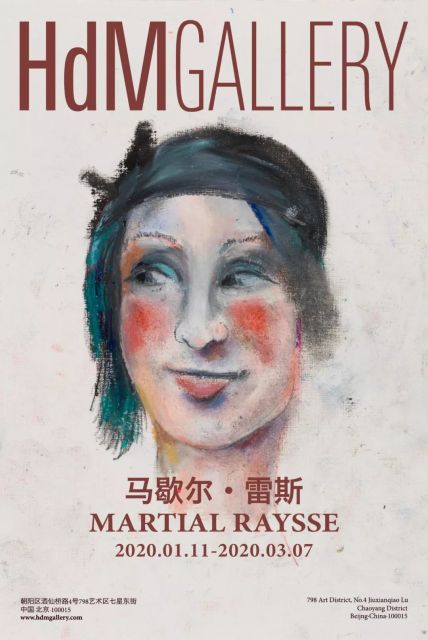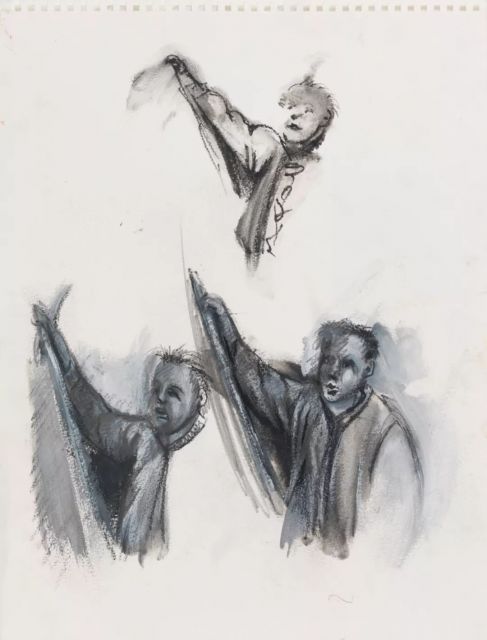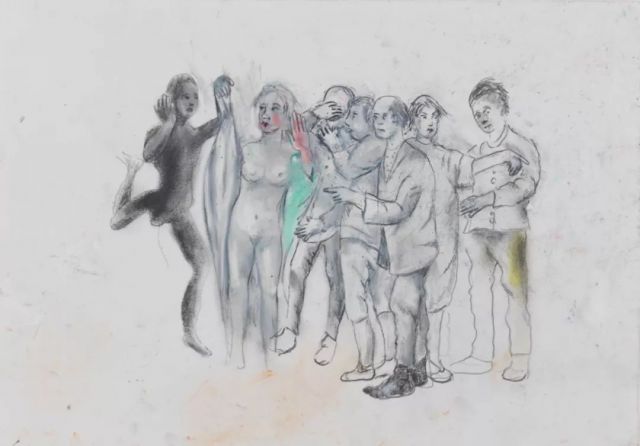
HdM GALLERY Beijing is pleased to present a solo show of an important French artist Martial Raysse. The show will include more than 20 works dated from 1980s to 2019. It will remain on view until March 7th, 2020.
About the Exhibiton
“The world is a farce full of grief and joy" according to Martial Raysse. Living discretely in the countryside of Bergerac, in the southwest of France, in the depth of the forest where the morning bells chime, Martial Raysse still looks out into the world.
In 2014, the Centre Pompidou held a retrospective exhibition celebrating 45-years anniversary of his practice for the then 78 years old Martial Raysse, for which the French newspaper Le Monde commented, "This is a painter who knows best about painting since Picasso." In fact, Matial Raysse was first enrolled in the department of literature at Nice University in 1954, and in the following year, he began to write large volumes of poetry. In 1960, as a central figure in the Nouveau-Réalisme movement, he wrote down the manifesto of the Nouveau-Réalisme on a 100 cm x 66 cm piece of paper with Yves Klein, Arman and others, thereby launched a revolutionary chapter in French contemporary art. Two years later, his installation, Raysse Beach became a classic in the French Pop Art scene. Thereon, his works expanded in the mediums of installation, collage, sculpture, theater, public art, experimental film, etc. that earned him a position in the New York art scene. It was at the peak of his practice, he resigned from Pop Art and was resolute to return to France, but not to live in Paris. He sought for a secluded plot of land in the countryside where he could return to the practice of painting. "I hope people would forget about everything I have done previously, and as of now, I am a new person, an impoverished new artist." Once he bid farewell to the Martial of the past and told the others his reasons for returning to France, Marcel Duchamp opened a drawer in his studio and showed him his secret practice – painting.

Martial Raysse, Paulo esquisse pour Mais dites une seule parole, 1994;
Painting, 32x41cm
Martial Raysse chose to lead a life in seclusion at the peak of his fame and began to work in a stone-structure studio. From the wind pierced through the forest, sweeping over the lawn and the dandelions in the courtyard, to the snow falling in the winter, there in the studio, he carried on a whisper with himself in this discrete world of his. His overview of the world has condensed into the center point, where he continued to translate the language from his heart and mind. What he contemplated and worked on there was similar to a monk’s as ascetic practices in the temples.
The canvas became the stage on which his inner world unfolded. The figures on stage were unrelated to the definitions of the history of painting, or even the history of art. Be it his large-dimension oil paintings, or these small drawings before our eyes, we could look at them without the framework of time. He portrayed the faces, expressions, demeanors of these figures. As he continued to deepen and enrich them, these figures floated among his paintings for decades. Like a never-ending play, the players take turns to come on and off stage, acting out the hustle and bustle of the world, a violent and restless world that seems at times absurd. In portraying this subtle theatre, we could perceive a different kind of presence unlike a master of painting. His drawings aspire for simplicity as well as excellence. How would one distinguish such works from the classical or modern? Since he's left behind the set of rhetoric for Pop Art, he's also rejected everything about formalism. Having settled down in an area filled with legends, where he listens to the church bells in the morning and appreciates the setting sun by sitting at the edge of the forest at dusk, he was able to execute his objects as he pleased, thereby reestablishes the order of things. These drawings are like the fragments of a mid-century recluse' secret life. He's adopted all of the small objects around him, ceramic pottery, vines and leaves, the rooster, a small sword, bathing suit – anything the hand would reach, and eyes would see – became important props, exhibiting their uniqueness. Everything that took place in this theatre is vital, organic, and all the awkward objects would be paired harmoniously as if they operate in an enigmatic pattern.

Martial Raysse, Trio, 2019; Painting, pastel on paper, 20.5x14.5cm
These small-dimension drawings are related to his large-scale oil paintings, and to those copper, steel and plaster sculptures large and small, the figures once again returned to the stage. As if they were headed to act in a large-scale play once they’ve done solo improvisations, to become a star or a self-fulfilling small role. These small figures often surround himself in the form of sculptures, scattered around the wall crevasse in his stone studio, at the shrine, next to the old furnace, and are carefully protected. They venerate each other through time, and over the years, they have become part of the legend of this region, and Martial Raysse was the one who created the legend.
If painting were to call on the presence of those absent, then Martial Raysse would have already achieved it with these small drawings. From looking at a face, a body, and an object, one would associate immense and complex things with them, imagine a nihilistic or actual world which ultimately reflects the individual's view of the world. The viewing of a painting is momentary, while one's imagination hitherto can be extensive. Looking at Martial Raysse's applying colors to the skin of the protagonist on canvas is that the texture of the animal flesh or that of the long-standing sculpture, or the clothing and vicinity around them, that kind of luscious splendor defies the intellect. Furthermore, Martial Raysse, a survivor of Fascism, was a boy who crossed over the Alps with his family overnight, his despair towards the world has never left his heart. So, as the art historian John Berger, who also chose to live in seclusion, once said, “Creativity, regardless of its beauty, nevertheless originates from suffering.”

Martial Raysse, étude pour Le lever du jour, 2016; Painting, 29.5x42cm
From these portraits and still-life, we would sense a subtle playfulness. Without knowing where these faces come from, or unable to categorize the social lingo these postures convey, standing in front of these paintings, your experiences of time and history have been compressed and folded. You neither have to know about the European history of art from the 16th Century nor the visual references to the history of contemporary art, these images are the artist's attitude towards the things around them, and they embody his complex sentiments. For Raysse, painting inevitably translates one's sensibilities of this time, while without being over engaged.
From Martial Raysse's journey in painting, one could witness his perseverance in the medium. When he held an exhibition in New York half a century later since his first, his intention was to safeguard painting – so it would never become a practice for the fools. For these drawings completed in Europe, their display in China, at an art gallery in Beijing for the Chinese viewers, the artist would believe that these works present a kind of psyche and quality, that which transcend nations, time, and historical experiences. They are works of art, drawings specifically, that have encapsulated the techniques and consciousness of the one who applied these lines and colors, completed at a certain time, and now, they confront the judgments in your heart and mind.
(Written by: Ju Baiyu)
About the Artist
Martial Raysse was born in 1936 in Vallauris, France, to a family of ceramicists, he now works and lives in Bergerac. His works have been well known since the 1960s, and he participated in the Venice Biennales of 1966, 1976, and 1982, and also in Kassel Documenta in 1968, 1977, 1992. In 2014, he was awarded the prestigious Praemium Imperiale for Painting by the Japan Art Association. Martial Raysse was exhibited widely in numerous institutions around the word, including MoMA, Le Centre national d'art et de culture Georges-Pompidou, Musée d’Art moderne de la Ville de Paris, Galeries Nationales du Grand Palais, Palais des Beaux-Arts,Modern Art Museum, Munich, Stedelijk Museum, etc. His work is included in numerous important public collections, including MoMA, Hirshhorn Museum and Sculpture Garden, Washington D.C., Ludwig Museum of Contemporary Art, Musée d'Art Contemporain Marseilles, S.M.A.K. Stedelijk Museum voor Actuele Kunst, Serralves Foundation Museum of Contemporary Art, Tsinghua University Art Museum, etc. Moreover, Martial Raysse was commissioned to design thenational stamp of France of 200 years in 1992.
About the exhibition
Dates: 11/01/2020 - 07/03/2020
Venue: HdM Gallery
Courtesy of the artist and HdM Gallery, for further information please visit www.hdmgallery.com.




























